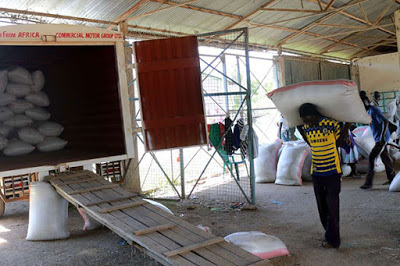Tanzania hopes to increase its rice
exports to Kenya and Rwanda by one-third this year, according to forecast by a
trade tracker.
exports to Kenya and Rwanda by one-third this year, according to forecast by a
trade tracker.
According to the East Africa Cross-border Trade
(EACT), the trade volume will be boosted by supplies from the August harvest
and high carry-over stocks, which are likely to lower prices. The low rice
prices are due to lower maize flour cost which is a substitute staple food to
rice.
(EACT), the trade volume will be boosted by supplies from the August harvest
and high carry-over stocks, which are likely to lower prices. The low rice
prices are due to lower maize flour cost which is a substitute staple food to
rice.
 |
| Workers loading bags of rice in Ahero, Kenya, for export to Uganda (Photo: The Nation) |
Amid trade disputes, Kenya is still Tanzania’s main
market for rice followed closely by Rwanda.
market for rice followed closely by Rwanda.
Tanzania projects to export 84,000 tonnes of the
locally produced rice to Kenya and 60,000 tonnes to Rwanda.
locally produced rice to Kenya and 60,000 tonnes to Rwanda.
Exports to Burundi will continue to be limited because
of the depreciation of the country’s franc and low purchasing power as the
economic situation worsens because of the effects of disputed 2015 presidential
election.
of the depreciation of the country’s franc and low purchasing power as the
economic situation worsens because of the effects of disputed 2015 presidential
election.
The EACT projects that rice exports from Uganda to
South Sudan will also continue to be minimal due to conflict-related trade
disruptions, South Sudan’s currency depreciation and low purchasing power due
to the subdues economic activity.
South Sudan will also continue to be minimal due to conflict-related trade
disruptions, South Sudan’s currency depreciation and low purchasing power due
to the subdues economic activity.
Re-exports of imported rice by Somalia to Kenya is
expected to shoot up between April and September to coincide with the holy
month of Ramadhan in May and the August Hajj celebrations.
expected to shoot up between April and September to coincide with the holy
month of Ramadhan in May and the August Hajj celebrations.
In Kenya, rice prices have been increasing due to a
decline in local production and expensive imports.
decline in local production and expensive imports.
However, maize continued to be the most regionally
traded commodity in the region. Towards the end of last year, maize prices in
most markets in East Africa declined due to increased harvests
traded commodity in the region. Towards the end of last year, maize prices in
most markets in East Africa declined due to increased harvests
In the months after the August harvest, maize prices
usually drop to lows of $20 per 90kg bag, even as the October long rain season
boosts the second-season harvest.
usually drop to lows of $20 per 90kg bag, even as the October long rain season
boosts the second-season harvest.
Bujumbura’s maize prices remain persistently high,
being the most costly in the region, whereas the grain was fetching the lowest
cost in Ethiopia due to the low cost of production.
being the most costly in the region, whereas the grain was fetching the lowest
cost in Ethiopia due to the low cost of production.
The low cost of maize sent Ethiopian traders to Kenya,
selling more maize last year than the previous years. Maize is the most traded
commodity across the region, followed by dry beans, rice and sorghum.
selling more maize last year than the previous years. Maize is the most traded
commodity across the region, followed by dry beans, rice and sorghum.
Uganda, Tanzania and Ethiopia are the main sources of
maize, but in September last year Kenya sold the grain to Uganda even as the
country was importing it from Mexico to plug a severe shortage. Maize prices
had fallen after the end of a long dry spell.
maize, but in September last year Kenya sold the grain to Uganda even as the
country was importing it from Mexico to plug a severe shortage. Maize prices
had fallen after the end of a long dry spell.




